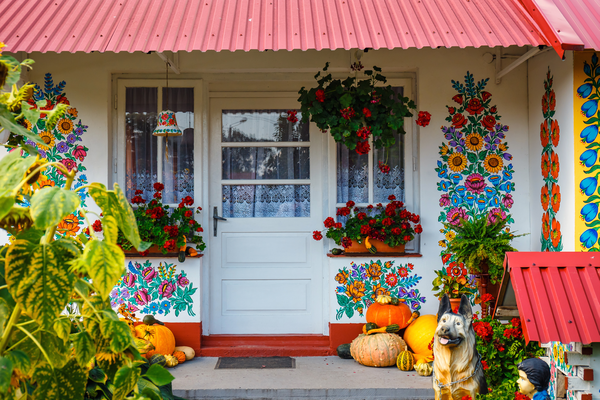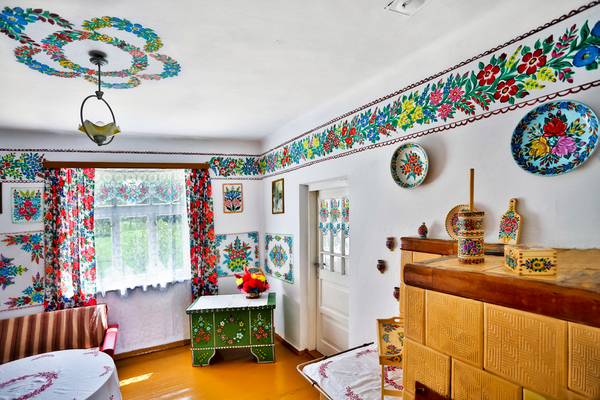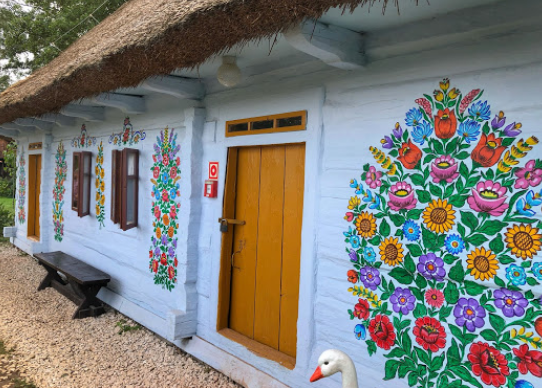Zalipie

[아츠앤컬쳐] 비스툴라(Vistula) 강과 두나제크(Dunajec) 강이 만나는 폴란드의 남동부 지방에서는 폴란드 시골 지역 중 가장 독특하고 아름답다고 알려진 잘리피에(Zalipie)를 만나볼 수 있다.
잘리피에에서 민속 예술은 다른 폴란드 지역보다 훨씬 선명한 특징을 드러낸다. 잘리피에 민속 예술의 명성은 19세기 후반에 시작된 지역 특유의 장신구로부터 시작된다. 당시 집에는 굴뚝이 없었기 때문에 난로의 연기가 방 안을 둥둥 떠다니며 실내를 어두컴컴하게 만들곤 했다. 이에 대한 대책으로 실내를 밝게 하기 위해서 여성들은그을음으로 검어진 벽에 흰색 반점을 칠하곤 하였다.

이때 끝이 잘게 찢긴 자작나무를 브러쉬로 사용하였는데, 시간이 지남에 따라 여성들은 브러쉬 끝을 더 얇게 만들 뿐만 아니라 점에 색깔을 더하여 그들의 정원이나 마을 어귀에서 자라는 장미, 모란, 루핀류 같은 꽃들로 표현하기 시작하였다. 할머니들은 이러한 꽃 아트를 딸들과 손녀들에게 가르쳤으며 20세기경 이 풍습은 아주 세밀하고 정교한 꽃을 그리는 전통으로 발전되었다.
오늘날에도 잘리피에의 재능 있는 여성들은 벽화를 그릴 뿐만 아니라 그들의 가구나 그릇, 잔, 창문 또는 문에 꽃을 그린다. 또한 집에 있는 장식품부터 시작하여 헛간, 닭장 및 개집의 외관까지 화려하게 장식한다. 몇몇 사람들은 창문에 걸 용도로 아름다운 데코레이션 종이를 만드는가 하면, 몇몇은 전통 의상 또는 테이블보에 자수를 놓기도 한다. 이 장식들이 여성들의 마음으로부터 우러러 나오는 상상력이자 자기 표현인 것을 고려할 때, 그들의 예술에는 한계가 없다고 볼 수 있다.

이러한 전통과 풍습이 사라지지 않도록 화가들의 꽃 디자인으로 집 꾸미기를 장려하기 위해 타르누프(Tarnów)의 민속 박물관은 60년대부터 “주택 페인팅” 대회를 개최하고 있다. 매년 봄, 6월에 성체 축일 이후 잘리피에와 주변 마을의 수많은 여성들은 대회에 참가하여 다양한 예술품들을 만들어내는데, 이 대회는 단 한 명도 빠짐없이 모두 상을 수상하도록 되어있다.
잘리피에에는 관광을 위해 예쁘게 꾸며진 건물들이 많다. 이 건물들 중 하나는 바로 현지 여성에 의해 수놓아진 미사 의복과 페인팅 된 사제석이 있는 가톨릭 교구 교회이다. 또 다른 하나는 지역 예술가들로 가장 유명한 펠리치아 쿠리워(Felicia Curyło) 박물관이다. 하지만 마을 내의 거의 모든 문화적 볼거리는 화가의 집(House of Painters)에 집중되어 있다. 여기에서 벽에 그려진 꽃다발 페인팅을 감상하고 기념품을 살 수 있을 뿐만 아니라 아름다운 지역 수공예품을 제작 중인 여성들도 만나볼 수있다.
또한 전통 데코레이션에 대한 정보를 얻을 수 있고, 페인팅 워크샵에도 참가할 수 있으며 “주택 페인팅” 대회를 기록으로 남긴 사진들과 민속 예술 전시회 관람, 포비실레 동브로프스키에(Powiśle Dąbrowskie) 예술가들의 작품과 좀 더 가까워지는 기회를 가질 수 있다.
http://dommalarek.pl/ 폴란드 독립 회복 100주년

Zalipie
In south-eastern Poland, where the Vistula and the Dunajec Rivers meet, you can find Zalipie, one of the most unique and beautiful places in the old Polish countryside.
In Zalipie, folk art is much more vivid than in other Polish regions. This folk fame has resulted from a local specific ornamentation tradition, which began in the late nineteenth century. In that times houses lacked chimneys and the smoke from the cottage hearths, floating around the main room, blackened the interior. To brighten the insides of their dwellings, women and girls used to paint white lime spots on walls
dark with soot.

Their brushes were birch sticks shredded at the end. Over time, women not only learned to make finer brushes but began to use color and so the primitive spots evolved into simple flowers — peonies, roses and lupines like those blooming in their village fields and gardens. Then grandmothers taught the floral art to daughters and granddaughters and by the 20th century the custom had fully evolved into a tradition of painting the detailed colorful flower compositions.
Today the more talented women of Zalipie not only decorate walls, they paint flower garlands on their furniture, china, glass and around window and doors. They also richly ornament the exteriors of their homes, barns, chicken coops and dog houses. Some of them make beautiful decorative papers hung in windows or embroider traditional costumes and tablecloths. There is no limit for their imagination and self-expression as it is art of the heart, and the art of the hearth & homemaking.

To encourage the painters to cultivate the tradition of covering houses with floral designs and prevent its disappearance, since the 60s the Ethno-graphic Museum of Tarnow organizes a “Painted Cottage” competition. Every spring, right after Corpus Christi in June, many women from Zalipie and surrounding villages create new art and enter their houses and farms in the contest. Everyone wins a prize.
It is worth mentioning that Zalipie has many beautifully decorated buildings available for sightseeing. One of them is Catholic parish church with painted presbytery and collection of liturgical attire embroidered by local women. Another is the Museum of Felicia Curyło, the most popular of local artists. However, the cultural life of the village is focused in the building of the House of Painters. There you can not only admire painted bouquets on the walls or buy souvenirs but also see women at work on the beautiful local crafts.

It is the place where you can get information concerning the tradition of decorating, take part in workshops on painting, see the exposition of folk art and photography documenting the “Painted Cottage” contest and also familiarize yourself with the work of the Powiśle Dąbrowskie artists.
http://dommalarek.pl/

